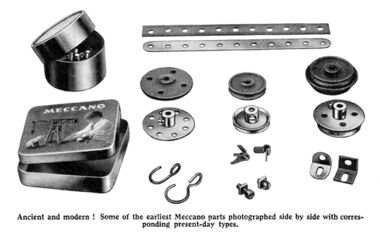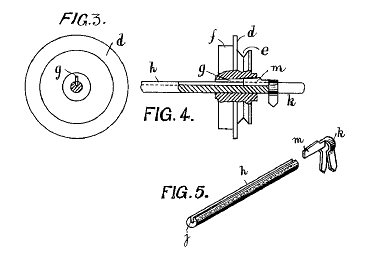The Evolution of Meccano
Meccano/Hornby/Dinky :
Mechanics Made Easy | Meccano | Super Models | Motor Car Constructor | Aeroplane Constructor | Dinky Builder | X-Series | Plastic
W UK US FR DE 1900s | 1910s | 1920s | 1930s | 1940s | 1950s | 1960s | 1970s |
Mechanics made Easy, vs. "modern" 1930s Meccano [image info]
Nuts
- The original MMS/Meccano nuts were square and fairly crude, and the difference in radius between the square corners and the centres of the flat faces meant that when the sharp-edged nuts were tightened onto coloured plates, they tended to carve away the paint leaving a nasty exposed silver circle.
- Meccano later switched to hexagonal nuts which were superior in almost every respect - they were easier to tighten with a spanner in confined spaces, allowing six possible angles of attack rather than four, and the way that they were punched out of the metal gave them one "rounded" side (good for low-friction mating with moving parts) and one more "concave" side (good for making solid high-friction contact with parts that were not supposed to move, or work loose).
- Additionally, even if you were using the high-friction side against a metal plate, the hexagonal corners weren't so sharp and didn't carve the paint as badly, and even if you managed to carve away a circle of paint, the hexagonal nuts left a much smaller "reveal" area, so the damage was less noticeable.
Bolts
- The original MMS/Meccano bolts or screws had high-sided cheesehead caps, which allowed the tightening slots to be quite deep. However, they screws still tended to fell off your screwdriver unless you used a magnet or a pair of fingers to hold them in place until the screwsthreads engaged.
- For the Aeroplane Constructor sets, Meccano used round-headed screws which looked more aerodynamic and had a less intrusively right-angled profile.
- In "Modern Meccano" sets, the screws or bolts still have high sides, but have a recessed Allen key socket. This gives the user six possible angles for their tightening tool (rather than two), and lets them place a screw onto the end of an Allen key or other tool, so that the same tool can be used to hold or position the screw before it's tightened. The use of Allen sockets also means that the user doesn't have to apply additional force to stop the screwdriver head slipping sideways out of position, making it easier to tighten screws, and the end result looks more modern and "engineered".
Strips
- The original "Mechanics Made Easy" strips were thin tinplate, with the long edges folded over to produce additional thickness and rigidity. The ends were simple guillotined at right angles, leaving sharp finger-lacerating edges.
- Meccano's distinctive solid stamped metal strips with rounded ends appeared later. These pieces wouldn't make a mess of your fingers, and the rounded ends meant that no matter what angle you used to connect the ends of a couple of strips, you'd always get a nice-looking joint profile.
Colours
- Meccano pieces were originally all metal-coloured (silver-coloured apart from some brass and brass-coloured pieces).
- In 1926, Meccano Ltd launched the red and green "The New Meccano" for the product's 25th anniversary, which had coloured parts (plates were usually painted dark red, strips and girders dark green).
- Around ten years later, they experimented with a makeover to a more luxurious-looking blue and gold, with the strips gold-painted, and the plates dark blue, with crosshatching.
- After the shutdown in production for WW2, Meccano reappeared .. with a reversion to the earlier "classic" red and green.
- A switch to lighter red and green happened in 1958, apparently coinciding with the switch to lead-free paint.
- After Lines Bros. took over Meccano, their "relaunch" included switching to predominantly yellow and black (which was useful for building models of yellow construction vehicles), with a few dark blue parts, and around the 1970s this had shifted to blue-and-yellow, with large baseplates being dark blue, strips being silver, and smaller plates such as trunnions being yellow. There were also special "army sets" in drab green.
There were also some minor colour variations between the French-made and UK-made parts, and some differences in adoption dates. The German-made "Märklin Meccano" (as Märklin Metall) started deliberately diverging away from the original after WW1 in terms of packaging, set contents and colours order to help establish their own identity. The Märklin sets tended to include more pieces in black.
Wheels and shafts
1901: Original "feather" fixing style. [image info]
1: The Feather/Bladecut
The original system used by Meccano for fixing wheels to shafts was the one detailed in Frank Hornby’s patent application, where wheels have a sawcut along the inside of the hole that takes the shaft. A special clip known as a feather then attached to the shaft, and a thin blade at one end of the clip engaged with the sawcut.
2: The Wedge
The first system did look slightly crude, and was replaced with a new way of connecting the parts which involved a rounded chunk taken out of one side of each wheel's shaft-hole, and a new clip attachment that clipped to the shaft and wedged into the cutout. The "curved wedge" clip attachment, with its curved surface, is referred to as a tongue. This version didn’t last particularly long, either, as it had some of the same disadvantages as the previous system, but was also more prone to slippage. During the transitional period, Meccano Ltd updated some of their sawcut stock to wedges, so it's possible to find part with both types of cutout.
3: The Screw
After one of Hornby’s visits ot the US to see off companies that were copying his Meccano system, Hornby seems to have returned to the UK realising that at least one of these companies had actually made a worthwhile improvement to part of his system – their wheels had a raised “boss” on one side that had a hole drilled into it and threaded, so that a side screw could be fitted and tightened against the shaft. Hornby promptly started usig the idea on official meccano parts.
4: The Double-tap Boss
To begin with, the new Meccano wheels and gears had just a single screwhole on one side of the boss. However, the addition of a second screwhole on the opposite side meant that users who were building delicately adjusted mechanisms such as long gear trains could carefully adjust the pair of screws to keep the driveshaft exactly centred – since these fittings needed to have a reasonably loose fit, if a boss only had one screw, the rod would always be pushed over to one side of the hole when the screw was tightened, making it slightly off-centre.
Another advantage of using an opposing pair of threaded holes was that both holes could be drilled in a single operation by drilling straight through the boss, and both could then be threaded in a single operation, by treated them as a single hole.
Almost all classic Meccano wheels and gears have either single-tap or double-tap fixings.
5: The Tri-Axle system
Simple rods still sometimes had a tendency to slip if they were under extremely heavy loads no matter how strongly you tightened the screws, unless you modified a section of rod by filing a flat surface onto part of it. Meccano later introduced the Tri-Axle system, which used Meccano-radius rods that had a flat surface on three sides, giving a cross section that looked like a triangle with the corners lopped off and rounded. These new rods worked as a direct replacement for existing Meccano rods, but allowed much more positive screw-locking.
The real incentive for producing the Tri-Axle rods, though, was to create a new system for fitting wheels to rods. Meccano were increasingly moving to using moulded plastic gearwheels and other plastic parts, and with a plastic moulded wheel, and the new three-sided axle, if the wheel had a matching rounded triangular mounting hole, the wheel could be push-fitted onto the shaft and would not be able to rotate with respect to the shaft. This meant that the new Tri-Axle-compatible wheels didn’t require a protruding boss or sidescrews, and could be both cheaper to make, and easier for the end-user to fit.




